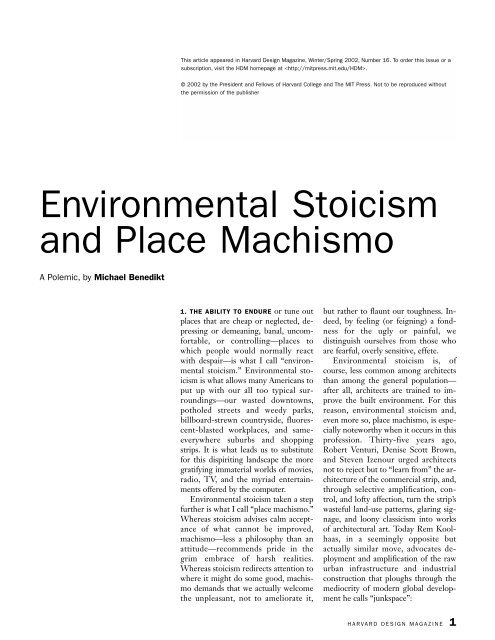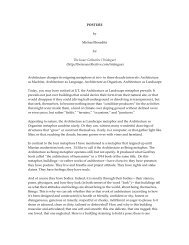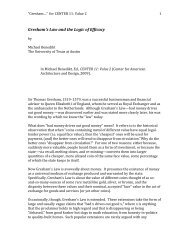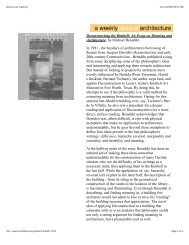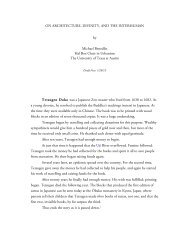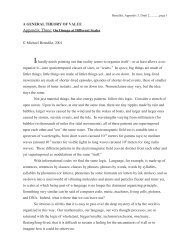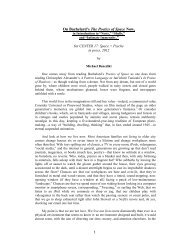Environmental Stoicism and Place Machismo: A ... - Michael Benedikt
Environmental Stoicism and Place Machismo: A ... - Michael Benedikt
Environmental Stoicism and Place Machismo: A ... - Michael Benedikt
You also want an ePaper? Increase the reach of your titles
YUMPU automatically turns print PDFs into web optimized ePapers that Google loves.
This article appeared in Harvard Design Magazine, Winter/Spring 2002, Number 16. To order this issue or a<br />
subscription, visit the HDM homepage at .<br />
© 2002 by the President <strong>and</strong> Fellows of Harvard College <strong>and</strong> The MIT Press. Not to be reproduced without<br />
the permission of the publisher<br />
<strong>Environmental</strong> <strong>Stoicism</strong><br />
<strong>and</strong> <strong>Place</strong> <strong>Machismo</strong><br />
A Polemic, by <strong>Michael</strong> <strong>Benedikt</strong><br />
1. THE ABILITY TO ENDURE or tune out<br />
places that are cheap or neglected, depressing<br />
or demeaning, banal, uncomfortable,<br />
or controlling—places to<br />
which people would normally react<br />
with despair—is what I call “environmental<br />
stoicism.” <strong>Environmental</strong> stoicism<br />
is what allows many Americans to<br />
put up with our all too typical surroundings—our<br />
wasted downtowns,<br />
potholed streets <strong>and</strong> weedy parks,<br />
billboard-strewn countryside, fluorescent-blasted<br />
workplaces, <strong>and</strong> sameeverywhere<br />
suburbs <strong>and</strong> shopping<br />
strips. It is what leads us to substitute<br />
for this dispiriting l<strong>and</strong>scape the more<br />
gratifying immaterial worlds of movies,<br />
radio, TV, <strong>and</strong> the myriad entertainments<br />
offered by the computer.<br />
<strong>Environmental</strong> stoicism taken a step<br />
further is what I call “place machismo.”<br />
Whereas stoicism advises calm acceptance<br />
of what cannot be improved,<br />
machismo—less a philosophy than an<br />
attitude—recommends pride in the<br />
grim embrace of harsh realities.<br />
Whereas stoicism redirects attention to<br />
where it might do some good, machismo<br />
dem<strong>and</strong>s that we actually welcome<br />
the unpleasant, not to ameliorate it,<br />
but rather to flaunt our toughness. Indeed,<br />
by feeling (or feigning) a fondness<br />
for the ugly or painful, we<br />
distinguish ourselves from those who<br />
are fearful, overly sensitive, effete.<br />
<strong>Environmental</strong> stoicism is, of<br />
course, less common among architects<br />
than among the general population—<br />
after all, architects are trained to improve<br />
the built environment. For this<br />
reason, environmental stoicism <strong>and</strong>,<br />
even more so, place machismo, is especially<br />
noteworthy when it occurs in this<br />
profession. Thirty-five years ago,<br />
Robert Venturi, Denise Scott Brown,<br />
<strong>and</strong> Steven Izenour urged architects<br />
not to reject but to “learn from” the architecture<br />
of the commercial strip, <strong>and</strong>,<br />
through selective amplification, control,<br />
<strong>and</strong> lofty affection, turn the strip’s<br />
wasteful l<strong>and</strong>-use patterns, glaring signage,<br />
<strong>and</strong> loony classicism into works<br />
of architectural art. Today Rem Koolhaas,<br />
in a seemingly opposite but<br />
actually similar move, advocates deployment<br />
<strong>and</strong> amplification of the raw<br />
urban infrastructure <strong>and</strong> industrial<br />
construction that ploughs through the<br />
mediocrity of modern global development<br />
he calls “junkspace”:<br />
HARVARD DESIGN MAGAZINE 1
Hard/Soft, Cool/Warm...<br />
<strong>Environmental</strong> <strong>Stoicism</strong> <strong>and</strong> <strong>Place</strong> <strong>Machismo</strong><br />
Junkspace is what remains after modernism<br />
has run its course, or more<br />
accurately, what coagulates while modernization<br />
is in progress, its fallout. Modernization<br />
had a rational program: to share<br />
the blessings of science, universally. Junkspace<br />
is its apotheosis or meltdown. . . .<br />
Junkspace is the sum total of our current<br />
architecture: we have built more than all<br />
previous history together, but we hardly<br />
register on the same scales. Junkspace is<br />
the product of the encounter between escalator<br />
<strong>and</strong> the air conditioning, conceived in<br />
an incubator of sheetrock (all three missing<br />
from history books). . . . It substitutes accumulation<br />
for hierarchy, addition for composition.<br />
More <strong>and</strong> more, more is more.<br />
Junkspace is overripe <strong>and</strong> undernourishing<br />
at the same time, a colossal security blanket<br />
that covers the earth. Junkspace is like being<br />
condemned to a perpetual jacuzzi with<br />
millions of your best friends. 1<br />
Junkspace is the l<strong>and</strong>scape that<br />
modern architecture was supposed to<br />
have saved us from in the last quarter<br />
century, but has really produced (albeit<br />
unintentionally, as the collateral of its<br />
advocacy of st<strong>and</strong>ardization <strong>and</strong> efficiency<br />
of construction). Junkspace is<br />
the new <strong>and</strong> stifling bourgeois environment<br />
underwritten by those who<br />
are, in effect, as careless about its cumulative<br />
effect on the psyche as about<br />
the long-term consequences of its creation<br />
for the planet. From the Koolhaasian<br />
perspective, better <strong>and</strong> more<br />
honest than junkspace, leaner <strong>and</strong><br />
therefore more to be liked are things<br />
like freeways, garages, bridges, communication<br />
towers, warehouses, <strong>and</strong><br />
distribution centers, both in themselves,<br />
unadorned <strong>and</strong> functional, <strong>and</strong><br />
for the lonely “existential” spaces that<br />
proliferate in <strong>and</strong> around them.<br />
In our postpostmodern times, Koolhaas’s<br />
place machismo has become a<br />
widely admired avant-garde position,<br />
one which asserts that better than inadvertent<br />
banality is deliberate <strong>and</strong> exaggerated<br />
banality, gr<strong>and</strong>er, more<br />
Nietszchian, more refined for being<br />
less refined, interested in the beauty<br />
not of (real) flowers arranged in a window<br />
but of railroad bridge abutments<br />
caught in an accidental beam of light.<br />
“The sublime without overblown pretension”<br />
is what Koolhaas admires <strong>and</strong><br />
by implication, what all architects<br />
should be after. 2 But Iris Murdoch’s<br />
words here might serve as a caution. As<br />
admirable as it is to face human suffering<br />
<strong>and</strong> at some level accept it, she argues,<br />
“Kant’s notion of the sublime . . .<br />
is a kind of romanticism. The spectacle<br />
of huge <strong>and</strong> appalling things can indeed<br />
exhilarate, but usually in a way that is<br />
less than excellent.” The fondness for<br />
the sublime “is nothing more than a<br />
form of romantic self-assertion.” 3<br />
There is little doubt that as the effluvium<br />
of development accumulates<br />
around the world, junkspace—an apt<br />
term for the stultifying norm of commercial<br />
good cheer indoors <strong>and</strong> the<br />
thinly disguised hegemony of real estate<br />
economics outdoors—increasingly<br />
becomes the thinking architect’s enemy.<br />
The question is whether a Koolhaasian<br />
amplification of infrastructural<br />
<strong>and</strong> industrial typologies will be any<br />
There is little doubt that as the effluvium of development<br />
accumulates, junkspace—an apt term for the stultifying<br />
norm of commercial good cheer indoors <strong>and</strong> the thinly<br />
disguised hegemony of real estate economics outdoors—<br />
increasingly becomes the thinking architect’s enemy.<br />
more effective, as antidote to junkspace,<br />
than Venturi’s have proven to<br />
be, or that the early modernists hoped<br />
to achieve in their attack on bourgeois<br />
sensibilities.<br />
Away from the extreme conditions<br />
that might justify it—war, exploration,<br />
dam building, <strong>and</strong> so on—stoic indifference<br />
to the discomforts of the immediate<br />
environment cannot be<br />
considered a virtue. 4 Nor can its extension<br />
into place machismo be recommended<br />
as a permanent stance<br />
toward the world, especially by designers.<br />
Both stoicism, over an extended<br />
period, <strong>and</strong> machismo, adopted as<br />
more than a passing fashion by the<br />
comfortable rich (I am thinking, for<br />
example, of “heroin chic”), will lead to<br />
further degradation of the urban <strong>and</strong><br />
natural environments: the first<br />
through the toleration of neglect, the<br />
second through the provocation of<br />
hostility from “ordinary” people, people<br />
who want the world to be pleasant.<br />
To see how architecture might<br />
progress ethically as a profession, we<br />
should attempt to create an etiology of<br />
environmental stoicism <strong>and</strong> place<br />
machismo. How did they arise? What<br />
are their manifestations? For both of<br />
them must be undone, or at least exposed<br />
for the defensive syndromes<br />
they are, if the appetite for the beautiful<br />
<strong>and</strong> the real is to be released in the<br />
population around us, <strong>and</strong> if an architecture<br />
unembarrassed to be healthful,<br />
gracious, <strong>and</strong> kind to human purposes<br />
is to resume its evolution.<br />
2. INSENSITIVITY TO THE ENVIRONMENT<br />
is closely linked to an attitude I call “exteriorism.”<br />
The distinction between<br />
“exteriorism” <strong>and</strong> “interiorism” unveils<br />
a deeper component of the tolerance of<br />
both junkspace <strong>and</strong> of the more brutish<br />
conditions of environments designed<br />
for maximum efficiency.<br />
Inside. Outside. What is the difference?<br />
Psychologically <strong>and</strong> experientially,<br />
the difference between being<br />
inside <strong>and</strong> outside is complex. Certainly<br />
the feeling of interiority—of being<br />
immersed, surrounded, enclosed—<br />
transcends the experience of rooms<br />
<strong>and</strong> other indoor enclosures, <strong>and</strong> extends<br />
to the out-of- doors (streets,<br />
squares, <strong>and</strong> parks bounded by trees<br />
<strong>and</strong> buildings). The feeling of interiority<br />
can also extend to pristine natural<br />
environments, where the stars or a<br />
tree canopy can seem like a ceiling,<br />
where the earth or a bed of leaves can<br />
feel like a floor, <strong>and</strong> a rock-face like a<br />
wall. “Embeddedness” is the metaphor<br />
<strong>and</strong> the dominant feeling.<br />
Equally <strong>and</strong> alternatively, one can<br />
feel oneself to be always outside things:<br />
© 2002 by the President <strong>and</strong> Fellows of Harvard College <strong>and</strong> The MIT Press. Not to be reproduced without the permission of the publisher<br />
2 HARVARD DESIGN MAGAZINE WINTER/SPRING 2002
Hard/Soft, Cool/Warm...<br />
<strong>Environmental</strong> <strong>Stoicism</strong> <strong>and</strong> <strong>Place</strong> <strong>Machismo</strong><br />
a body next to <strong>and</strong> among other bodies,<br />
always in orbit around them or on<br />
some trajectory with regard to them.<br />
These other bodies are things whose<br />
interiors are inaccessible or that reveal,<br />
when broken open, yet more outsides:<br />
smaller bodies inside with unbreachable<br />
shells, “components,” jostling, poised,<br />
or circulating in empty space.<br />
The first response is “interiorist,”<br />
the second “exteriorist.” These two responses<br />
are logically complementary<br />
but emotionally different. What is an<br />
onion, formally? A tiny seed embedded<br />
in a series of cupping shells, or a<br />
series of near-spheres each covering<br />
the one inside? It makes no logical difference<br />
whether one starts from the<br />
inside <strong>and</strong> moves out, or starts from<br />
the outside <strong>and</strong> moves in, but it makes<br />
a great deal of difference to how one<br />
feels about the onion—or rather, how<br />
it would feel to make or be an onion.<br />
The exteriorist wants to paint each<br />
Russian doll on the outside; the interiorist<br />
wants to line each enclosing doll’s<br />
inner, concave surface. In text, sensibility,<br />
<strong>and</strong> photography, Architectural<br />
Record is dominantly an exteriorist<br />
publication even when it presents interiors,<br />
while Nest is interiorist even<br />
when it shows exteriors. 5<br />
More than some recondite distinction<br />
to worry over in architectural theory,<br />
these two readings represent two<br />
fundamental orientations to being-inthe-world,<br />
<strong>and</strong> they are influential in<br />
areas beyond the design of buildings.<br />
Aristotle, Leibniz, <strong>and</strong> Einstein, I<br />
would argue, were “interiorists,” while<br />
Plato, Newton, <strong>and</strong> Bohr were “exteriorists.”<br />
Aristotle’s theory of space was a<br />
theory of places defined as successive<br />
layers of embeddedness in circumscribing<br />
surfaces: a river’s place was the<br />
riverbed. Leibniz’s monads were relational,<br />
each monad like a tiny silver ball<br />
reflecting the million other monads<br />
disposed around it <strong>and</strong> having no character<br />
apart from them. In his General<br />
Theory, Einstein extrapolated from<br />
how gravitation <strong>and</strong> acceleration would<br />
be experienced by an acute observer,<br />
<strong>and</strong> from what that observer would see<br />
of another moving observer’s clock, just<br />
as in his Special Theory of Relativity,<br />
he had wanted to know what one would<br />
experience while traveling at the speed<br />
of light. Newton, on the other h<strong>and</strong>,<br />
followed Plato in striving to take the<br />
view from nowhere, which is to say the<br />
view from everywhere at once. The<br />
universe in this view consisted of discrete<br />
bodies <strong>and</strong> atoms acting on each<br />
other’s motion by impact or gravity,<br />
which is action-at-a-distance. 6 The observer<br />
was one more such body. Matter<br />
was impenetrable <strong>and</strong> utterly hard;<br />
space was empty <strong>and</strong> “soft.” That is<br />
what made each what they were. Niels<br />
Bohr’s idea of the atom followed the<br />
same model (as do most theories of<br />
particle physics today, save quantum<br />
field theory). Ptolemy’s cosmology was<br />
interiorist; Copernicus’s exteriorist. In<br />
psychology, behaviorists <strong>and</strong> functionalists<br />
are exteriorists; existentialists<br />
<strong>and</strong> phenomenologists are interiorists.<br />
And so on.<br />
William Gass has eloquently described<br />
what the exteriorist orientation<br />
entails, <strong>and</strong> what it costs us psychically.<br />
“[S]uppose we put a spade in the<br />
earth,” he writes,<br />
the earth being a softer medium; our<br />
deepest dig will heave to view only another<br />
surface, this one crumbly perhaps, or<br />
with its clay compacted by the brutality of<br />
the blade. We can dig <strong>and</strong> delve like the<br />
most industrious duck; we can poke <strong>and</strong><br />
pry: we shall find nothing but surface.<br />
Surfaces are unreal. They have only one<br />
side—their “out” side—<strong>and</strong> as far as our<br />
world is concerned, outside goes on forever.<br />
So if we feel lonely cooped up in our<br />
consciousness—a prisoner “inside”—we<br />
can take cool comfort from the fact that<br />
outside we are simply surface, <strong>and</strong> have<br />
plenty of company. If you like, consciousness,<br />
either real or implied, is the other,<br />
missing side of surface. 7<br />
With this passage in mind, we are<br />
led to believe that environmental sensitivity<br />
<strong>and</strong> environmental stoicism reveal<br />
an interiorist orientation because<br />
the very concept of environment—of<br />
milieu—makes sense only from inside<br />
things, looking out <strong>and</strong> around. <strong>Place</strong><br />
machismo, in contrast, suggests the<br />
exteriorist sensibility, because in reducing<br />
place to an ensemble of things<br />
that “see” each other’s outward surfaces<br />
only, it denies the cognitive or<br />
emotional validity of interiority as an<br />
equally universal perspective.<br />
If consciousness is inside looking<br />
out, as Gass suggests, then the difference<br />
between interiorist <strong>and</strong> exteriorist<br />
is not the same as that between<br />
subjectivity <strong>and</strong> objectivity. Both interiorist<br />
<strong>and</strong> exteriorist readings can be<br />
subjective or objective. 8 That we so<br />
easily make the pairing “interiorist =<br />
subjective” <strong>and</strong> “exteriorist = objective”<br />
only demonstrates the male bias<br />
of the sciences toward the Newtonian,<br />
exteriorist orientation.<br />
Also, as Marshall McLuhan might<br />
have pointed out, each of the five senses<br />
encourages one orientation or the<br />
other. Dependence on picture-vision<br />
tends to support exteriorism, whereas<br />
dependence on hearing, kinesthesia,<br />
smell, or radar-vision—seeing the arrayed<br />
proximity of things around us<br />
rather than their composed shapes relative<br />
to each other—supports interiorism.<br />
9 These sensory inclinations are<br />
so subtle, however, that the intellect<br />
can readily override them.<br />
3. IN THIS ANALYSIS, the exteriorist/interiorist<br />
distinction is not gendered—<br />
or not yet gendered. The problematic<br />
gendering of interiorist <strong>and</strong> exteriorist<br />
readings of the world entered the rhetoric<br />
of modern architecture early,<br />
however, <strong>and</strong> it remains with us. “The<br />
repression of materiality in certain<br />
strains of contemporary architecture,”<br />
writes Jennifer Bloomer, “lies on a<br />
continuum of repressions in modernism,<br />
a continuum of the embrace of<br />
masculinity <strong>and</strong> the consequent pressure<br />
for men to reject things female<br />
both within <strong>and</strong> without themselves.<br />
This casting out of the interior from<br />
architecture proper, the division of<br />
what was once unified in architecture—interior<br />
design <strong>and</strong> architectural<br />
design—into two stereotypically gendered<br />
professions is a symptom of this<br />
repression.” 9 Bloomer makes an iden-<br />
© 2002 by the President <strong>and</strong> Fellows of Harvard College <strong>and</strong> The MIT Press. Not to be reproduced without the permission of the publisher<br />
3 HARVARD DESIGN MAGAZINE WINTER/SPRING 2002
Hard/Soft, Cool/Warm...<br />
<strong>Environmental</strong> <strong>Stoicism</strong> <strong>and</strong> <strong>Place</strong> <strong>Machismo</strong><br />
tification here between “materiality”<br />
<strong>and</strong> “interiority” that seems worth<br />
considering, especially if one thinks of<br />
space itself as one of the materials in<br />
question.<br />
Consider the idea that architectural<br />
design is about shaping space—an idea<br />
developed almost entirely in the 20th<br />
century <strong>and</strong> made a design studio commonplace<br />
by the popularity of two<br />
books—Sigfried Giedion’s Space, Time,<br />
<strong>and</strong> Architecture (1941) <strong>and</strong> Bruno<br />
Zevi’s Architecture as Space (1957)—<br />
whose ideas have a grip on the architectural<br />
imagination <strong>and</strong> its vocabulary<br />
to this day. One would think that space<br />
would have been an essentially “feminizing”<br />
notion. After all, if architecture<br />
is properly about space, then it is not<br />
about objects or tools or things. But<br />
this is to overlook the fact that to conceive<br />
of space as “shape-able” by design<br />
is to treat it as a sculptor would. It<br />
is to transform space from something<br />
oceanic or atmospheric, from something<br />
fecund, field-like, <strong>and</strong> interiorly<br />
structured, into something with an exterior<br />
to which one could apply a tool.<br />
“The architect models in space as a<br />
sculptor in clay,” wrote Geoffrey Scott<br />
in the second decade of the 20th century.<br />
10 I can think of no architect (or<br />
writer on architecture) who has since<br />
disagreed. This tacit agreement has allowed<br />
most architects to consider the<br />
tactile quality of materials—e.g., the<br />
difference between soft-to-the-touch<br />
surfaces <strong>and</strong> hard ones—only passingly,<br />
to draw a blank when it comes to<br />
visualizing color <strong>and</strong> surface patterning,<br />
<strong>and</strong> to trivialize incidental spacemaking<br />
elements like fabrics, whether<br />
loose, thrown, enwrapping, pinned, or<br />
wind-blown. Thus has an opportunity<br />
been lost to read the world as “endless<br />
interiority” <strong>and</strong> densely relational—a<br />
sensibility all but driven underground<br />
by the reductive desire to shape <strong>and</strong><br />
comm<strong>and</strong> things which have interiors<br />
that don’t matter, that don’t touch (in<br />
both senses of the word).<br />
My intention here is not to invent a<br />
new parlor game—“If Peter Eisenman<br />
is an exteriorist <strong>and</strong> Christopher<br />
Alex<strong>and</strong>er an interiorist, then what is<br />
<strong>Michael</strong> Graves?” Rather, I believe<br />
that there are important implications<br />
for architecture <strong>and</strong> education.<br />
As a teacher of design, I can attest<br />
that students (men or women) who refuse<br />
to or cannot become exteriorists<br />
are often criticized by place-macho<br />
studio critics who judge as soft-headed<br />
anyone struggling intuitively to put<br />
environmental experience ahead of<br />
form making <strong>and</strong> tectonics. Appeals to<br />
“experience” abound, of course, in<br />
many architectural schools as they do<br />
in practice. But the lack of a way to describe<br />
<strong>and</strong> map sensory experience <strong>and</strong><br />
to make it a part of design plagues the<br />
field to this day, notwithst<strong>and</strong>ing the<br />
comparative ease with which “perspectives”<br />
can be generated by CAD software.<br />
11<br />
4. AS THE HUNDRED-YEAR WAR against<br />
interiority rages on, perhaps the place<br />
where we see the battle lines drawn<br />
most clearly is in the perennial contestation<br />
over the status of interior design<br />
as an art, a profession, <strong>and</strong> a discipline.<br />
Although this is beginning to change,<br />
it is still generally true that we architects,<br />
male <strong>and</strong> female, have to be careful<br />
not to like curtains or to know too<br />
much about color <strong>and</strong> fabrics. Architecture<br />
<strong>and</strong> Architectural Record are the<br />
profession’s periodicals, not Architectural<br />
Digest or Nest. Erecting things is<br />
our expertise—or fighting off the<br />
weather, or deploying the latest technologies,<br />
or “exploring geometries” (a<br />
peculiarly male <strong>and</strong> cabalistic pursuit).<br />
Our mindset is “masculine”: we see<br />
buildings as edifices, monuments, devices,<br />
or statements, not as places, shelters,<br />
harbors, or succor. To us,<br />
buildings are objects among objects,<br />
hard <strong>and</strong> stiff, with shapes that do<br />
things <strong>and</strong> forms that perform, not enclosures<br />
or diaphanous matrices of<br />
light <strong>and</strong> sound <strong>and</strong> smell.<br />
What scorn many architects have<br />
for interior designers! “Licensing for<br />
interior designers? Come on! The best<br />
of them are architects, anyway.” 12<br />
Such attitudes, of course, reveal not<br />
just pettiness—not just tough-guy<br />
chauvinism, place machismo, professional<br />
jealousy, class resentment, <strong>and</strong><br />
maybe a touch of homophobia—but<br />
also the inability of the contemporary<br />
architectural imagination to address<br />
the full range of human needs, to engage<br />
all our senses, or to indulge even<br />
a few of our sentiments about issues<br />
not compartmentalizable into “use,”<br />
“performance,” or “form.” The window-wall<br />
+ sleek cabinet + Barcelona<br />
chair formula does not begin to constitute<br />
the universal solution to interior<br />
design that many architects have<br />
thought it does.<br />
Departments of interior design, as<br />
they become absorbed into schools of<br />
architecture, must resist st<strong>and</strong>ard architectural<br />
biases if they wish to preserve<br />
their sensibilities. They should<br />
refuse to be renamed departments of<br />
“interior architecture.” Such renaming<br />
is the first step to ideological colonization.<br />
Interior design teachers will have<br />
to develop their own body of theory<br />
<strong>and</strong> their own vocabulary, one that<br />
does not shrink from incorporating<br />
technical knowledge about light, air<br />
movement, <strong>and</strong> acoustic ambience, or<br />
from articulating the interiorist world<br />
view <strong>and</strong> all its sensitivities—sensitivities<br />
to texture, pattern, color, style,<br />
touch, nearness, arrangement, personality,<br />
<strong>and</strong> domesticity, to “charged”<br />
objects (the life in inanimate things), to<br />
class, <strong>and</strong> to the power of people<br />
themselves—of their clothed, warm,<br />
breathing bodies—to transform any<br />
environment by their presence. 13<br />
Complete architects weld the two<br />
sensibilities—exteriorist <strong>and</strong> interiorist—into<br />
a balanced, dynamic whole.<br />
Not only must they read <strong>and</strong> design<br />
the world as sculptors/engineers, that<br />
is, largely from the outside, but they<br />
also must make clear in their work that<br />
interior <strong>and</strong> l<strong>and</strong>scape have been conjoined<br />
by an architecture that underst<strong>and</strong>s<br />
itself as a realm between the<br />
two, with the whole able to be experienced<br />
always from the inside, even outdoors.<br />
Alas, there is only so much that a<br />
polemic like this can do (or any theoretical<br />
elaboration of it could do) to<br />
bring about a better balance between<br />
© 2002 by the President <strong>and</strong> Fellows of Harvard College <strong>and</strong> The MIT Press. Not to be reproduced without the permission of the publisher<br />
4 HARVARD DESIGN MAGAZINE WINTER/SPRING 2002
Hard/Soft, Cool/Warm...<br />
<strong>Environmental</strong> <strong>Stoicism</strong> <strong>and</strong> <strong>Place</strong> <strong>Machismo</strong><br />
interiorist <strong>and</strong> exteriorist orientations<br />
in architectural practice, or to degenderize<br />
it. The effects of revisionism<br />
in architectural theory are as slow in<br />
coming as they are lasting once established.<br />
Besides, being human, few students<br />
(<strong>and</strong> few teachers) of<br />
architecture are convinced by ideas—<br />
<strong>and</strong> even less by “oughts”—until they<br />
find some point of application, some<br />
mode of production (be it buildings,<br />
drawings, or models), or some problem<br />
in society that can be solved by<br />
uniting powerful ideas <strong>and</strong> architectural<br />
practice.<br />
Perhaps the continuing proliferation<br />
of “shelter” publications (on gardening,<br />
home improvement, interior design,<br />
<strong>and</strong>, yes, architecture) will do some<br />
good—books <strong>and</strong> magazines whose effect<br />
is to teach people that it’s OK to<br />
experience their environment more<br />
sensitively <strong>and</strong> hold it to higher st<strong>and</strong>ards.<br />
14 Contemporary shelter-<strong>and</strong>style<br />
magazines, from House & Garden<br />
<strong>and</strong> Southern Living to Wallpaper <strong>and</strong><br />
Côte Sud are doing a job for which architects<br />
ought to be grateful, whatever<br />
quibbles they might have about the<br />
taste culture(s) being promoted. And<br />
the slowly but steadily increasing power<br />
<strong>and</strong> authority of women in art, culture,<br />
business, politics, <strong>and</strong> intellectual life<br />
also offers hope, so long as the “feminine,”<br />
interiorist perspective is not itself<br />
lost in the process of acculturation<br />
to male worlds.<br />
5. I WANT TO CLOSE by proposing one<br />
specific effort that I believe would<br />
lessen the need for place stoicism <strong>and</strong><br />
insensitivity, namely improving the<br />
design of schools, <strong>and</strong> especially of<br />
high schools. For, setting aside the influence<br />
of action-oriented television<br />
<strong>and</strong> movies <strong>and</strong> the seemingly innate<br />
appeal to young men of the whole military<br />
mindset, high school is where environmental<br />
stoicism is, in effect,<br />
taught. 15 Let me explain.<br />
Visit a suburban American high<br />
school, vintage 1965 or later. Very likely<br />
it will be a building as bl<strong>and</strong> as a<br />
warehouse, as hardened as a prison,<br />
one where you are inspired to do nothing<br />
but escape its echoing din. 16 Does<br />
its design demonstrate our respect for<br />
youthfulness <strong>and</strong> learning? Does it reveal<br />
sympathy with the teenagers who<br />
have to spend so many hours sitting in<br />
windowless classrooms? Is there any<br />
place for the shy to dream? A leafy<br />
courtyard? The answer to all these<br />
questions is almost always “no.” One<br />
has to wonder why.<br />
City <strong>and</strong> school administrators will,<br />
of course, give several economic <strong>and</strong><br />
demographic reasons for the soullessness<br />
of school design, if they recognize<br />
it at all. But architects have been complicit,<br />
for it was thanks to the pioneering<br />
efforts of several large architecture<br />
firms that high school construction, responding<br />
to the postwar baby boom,<br />
became subject to the same optimization<br />
<strong>and</strong> rational planning principles<br />
that had been developed for manufacturing<br />
plants. 17 Faith in clear programs,<br />
in simple <strong>and</strong> flexible spaces, in<br />
lightweight construction, <strong>and</strong> so on,<br />
represented progressive thinking<br />
among firms of the day. The goal, then<br />
<strong>and</strong> now, was efficiency—defined in the<br />
narrowest engineering <strong>and</strong> economic<br />
terms, <strong>and</strong>, of course, suppression of<br />
any “sentimental” interiorist features<br />
that might add cost or complication. 18<br />
Arguably, the book that began the<br />
school design revolution, as it was then<br />
called, was William Wayne Caudill’s<br />
Toward Better School Design. 19 Written<br />
before the inclusion of air conditioning<br />
was automatic, the book recommends<br />
natural lighting, noncompact plans,<br />
<strong>and</strong> visual openness to the outdoors—<br />
all to the good. But its fundamental<br />
message was the value of efficiency, of<br />
fast, lightweight construction, <strong>and</strong> of<br />
the kind of organization—of curriculum,<br />
administration, <strong>and</strong> building layout—that<br />
could be shown on a simple<br />
chart. And it was these factors that, by<br />
the 1970s, dominated school design<br />
<strong>and</strong> that devolved, in the h<strong>and</strong>s of<br />
firms specializing in “educational facilities,”<br />
into the school buildings we still<br />
use today. 20 Under the pressures resulting<br />
from the reduced revenues<br />
caused by property tax revolt, the logic<br />
of efficiency became relentless. If<br />
teenagers are to learn from books <strong>and</strong><br />
blackboards <strong>and</strong> teachers’ faces, they<br />
shouldn’t need to look out windows.<br />
Therefore classrooms had few, high, or<br />
no windows. If teenagers are messy,<br />
then schools should be easy to clean—<br />
all linoleum <strong>and</strong> tile. If seventy-five<br />
Visit a suburban American high school, vintage 1965 or later.<br />
Very likely it will be a building as bl<strong>and</strong> as a warehouse,<br />
as hardened as a prison, one where you are inspired to do<br />
nothing but escape its echoing din.<br />
foot-c<strong>and</strong>les at desk height is the ideal<br />
illumination, then so it should be,<br />
everywhere, always, <strong>and</strong> without shadow.<br />
Energy consumption a problem?<br />
Make the building as tight as a refrigerator.<br />
Most efficient size? Bigger <strong>and</strong><br />
jam-packed. Theft a problem? Locks<br />
<strong>and</strong> bars. Misbehavior? Video cameras<br />
scanning every room, stair, <strong>and</strong> hallway.<br />
Communications? A public address<br />
system. Furniture abused? Make<br />
it steel <strong>and</strong> rock-hard plastic, <strong>and</strong> bolt<br />
it down. L<strong>and</strong>scape? Shrubs around<br />
the parking lot; a bubbler near the<br />
bleachers.<br />
This is the environment, barely<br />
better than a minimum security<br />
prison, in which millions of teenagers<br />
have spent years of their lives at an age<br />
when they are sorting out who they<br />
are, what counts, <strong>and</strong> what their value<br />
is to their peers <strong>and</strong> society. The implicit<br />
message they receive from<br />
schools built on these principles is that<br />
teenagers are incipient delinquents<br />
whose sensitivity is best disregarded<br />
<strong>and</strong> whose individuality is to be asserted<br />
by strategic choice of clothing <strong>and</strong><br />
stoic, aggressive, or subversive behavior<br />
toward the environment. Whatever<br />
these young people might learn about<br />
social interaction, the main response<br />
they learn to the place itself is abuse,<br />
neglect, or insensibility to the physical<br />
© 2002 by the President <strong>and</strong> Fellows of Harvard College <strong>and</strong> The MIT Press. Not to be reproduced without the permission of the publisher<br />
5 HARVARD DESIGN MAGAZINE WINTER/SPRING 2002
Hard/Soft, Cool/Warm...<br />
<strong>Environmental</strong> <strong>Stoicism</strong> <strong>and</strong> <strong>Place</strong> <strong>Machismo</strong><br />
discomfort it causes or to the insult it<br />
implies to them <strong>and</strong> to the process of<br />
education.<br />
Schools that don’t provide students<br />
with some personal space—for example<br />
their own desks or small-group<br />
private zones (bay windows, alcoves,<br />
outdoor seat clusters, etc.)—schools<br />
that by their materials <strong>and</strong> surfaces<br />
show no trust in students’ self-control,<br />
buildings that reflect not the adventure<br />
<strong>and</strong> exhilaration of learning or the<br />
simple joy of being young but instead<br />
the single-minded efficiency of an industrial<br />
plant, schools whose design<br />
suggests no pride in themselves as institutions—these<br />
schools underst<strong>and</strong>ably<br />
produce adolescents who burst<br />
out of them as if from purgatory. Primary<br />
<strong>and</strong> secondary education may<br />
rightly be compulsory, but this should<br />
not mean that the sites of education<br />
should be like penitentiaries. Schools<br />
like those I am describing have not<br />
only fostered environmental stoicism,<br />
they have also done immeasurable<br />
damage to learning, damage that has<br />
been measured in empirical studies. 21<br />
It is always easier to identify problems<br />
than to solve them. Changes in<br />
entrenched cultural attitudes are needed<br />
if we are to have more humane high<br />
schools. But not to offer any strategies<br />
to promote change would be to surrender<br />
to the stoicism I have been railing<br />
against. So here is a start:<br />
Foremost, of course, government at all<br />
levels should allocate greatly increased<br />
funding for school buildings. Some<br />
form of “school choice” would make<br />
school environments one of the points<br />
of competition between schools. And<br />
in architecture? The kind of innovation<br />
we have seen applied to museum<br />
design in the 1990s needs to be applied<br />
to school design in the 2000s.<br />
School design competitions can be a<br />
spur; a few modest ones have been<br />
held in recent years. The New York<br />
City Construction Authority sponsored<br />
one in 1998; the 1997–1998<br />
AIA/DuPont-Benedictus Awards International<br />
Student Design Competition<br />
was for a high school. 22 Chicago<br />
Public Schools recently held a national<br />
design competition. 23 The National<br />
Endowment for the Arts has started a<br />
program to award grants in competitions<br />
for public buildings, with a special<br />
focus in 2002 on schools. 24 Single<br />
leaders can make a difference: Thom<br />
Mayne’s exemplary Diamond Ranch<br />
High School was built only because<br />
Morphosis’s signature creativity was<br />
understood <strong>and</strong> welcomed by Patrick<br />
Leier, Superintendent of the Pomona<br />
Unified School District in California.<br />
The Ross School in East Hampton,<br />
New York, a refined traditionalist environment<br />
that has a mission to be a<br />
model for new schools, was built under<br />
the direction <strong>and</strong> funded by the<br />
philanthropy of Steven J. <strong>and</strong> Courtney<br />
Ross.<br />
When the public sees what architects<br />
can do when they set aside the formulae<br />
that have guided school design for forty<br />
years, a new era might begin—one in<br />
which architecture reinforces rather<br />
than undercuts education, one in which<br />
teenagers will feel free to be more sensitive<br />
to the built environment <strong>and</strong> to<br />
dem<strong>and</strong> more from it. When environmental<br />
stoicism wanes, when place<br />
machismo has had its day <strong>and</strong> architects<br />
begin to address the gamut of human<br />
needs with all their goodwill <strong>and</strong> intelligence,<br />
place sensitivity will emerge <strong>and</strong><br />
flourish.<br />
Notes<br />
1. Rem Koolhaas, cited by Gary Wolf in “Exploring<br />
the Unmaterial World,” Wired, June<br />
2000, 310. Most architects (<strong>and</strong> academics) I<br />
know are baffled by Koolhaas, not quite knowing<br />
how to reconcile the bitter-pill rhetoric he offers<br />
on the one h<strong>and</strong> with his own pedal-to-the-metal<br />
practice at OMA on the other. Wolf, in the article<br />
cited above, concludes: “‘Junkspace,’ I<br />
thought, was Koolhaas showing just how much<br />
pain he could take. But the [rhetoric’s] extravagant<br />
brutality also suggests that just as the architect<br />
is achieving international fame, he is<br />
reaching the end of a phase of his career. Junkspace<br />
condemns everything. It’s like a horror<br />
movie in which the protagonist dies along with<br />
everyone else.”<br />
The subjects for two of Koolhaas’s GSD research<br />
seminars—shopping <strong>and</strong> the sprawl of Lagos,<br />
Nigeria, published as The Harvard Design<br />
School Guide to Shopping (R. Koolhaas, ed., [New<br />
York: Taschen America, 2002]) <strong>and</strong> Mutations<br />
(Koolhaas, et. al. [Barcelona, Spain: Actar Editorial,<br />
2001]) respectively—were selected for study,<br />
I surmise, precisely in order to beat the architecture<br />
establishment about the head with Reality—<br />
<strong>and</strong> more than this, to dare its avant-garde<br />
members (<strong>and</strong> Koolhaas’s personal competition)<br />
to embrace what they absolutely cannot <strong>and</strong> he<br />
can: to wit, the shamefully wasteful l<strong>and</strong>scape of<br />
American consumerism on the one h<strong>and</strong> <strong>and</strong> the<br />
brutally pragmatic modernism of Asia or impoverished<br />
Africa on the other. Warhol meets Beuys<br />
meets Burroughs meets . . . .<br />
2. Koolhaas in conversation, 1997, speaking<br />
about the art of Yves <strong>and</strong> Uecker Klein, <strong>and</strong> the<br />
radical ’60s movement Fluxus. See<br />
www.ArchiNed.nl/htdig/index.html.<br />
3. Sovereignty of Good (New York <strong>and</strong> London:<br />
Routledge, 1971), 73.<br />
4. One might add sports, camping, <strong>and</strong> adventure<br />
travel to the list. Here a certain level of physical<br />
discomfort is expected <strong>and</strong> suffered, if not sought,<br />
because it is a condition of a different category of<br />
reward. Important to remember, lest one be<br />
tempted to use this as a model for “rigorous”<br />
hard-to-bear architecture everywhere, is that, in<br />
sport <strong>and</strong> the like, the discomfort suffered is voluntary<br />
<strong>and</strong> temporary, <strong>and</strong> the rewards for suffering<br />
powerful—e.g., personal victories, endorphin<br />
rushes, camaraderie, exclusive <strong>and</strong> exotic experiences,<br />
dangers overcome, endurance recounted,<br />
<strong>and</strong> so on). Very few building-types can legitimately<br />
impose such strenuousness on comparable<br />
grounds, <strong>and</strong> certainly none where people cannot<br />
choose, without loss, not to be there, such as<br />
those in which they learn, work, shop, <strong>and</strong> live, or<br />
travel through or walk by, on a daily basis.<br />
5. Ironically, popular interior design <strong>and</strong> shelter<br />
magazines are often exteriorist in sensibility.<br />
This is certainly the case when furniture, art, <strong>and</strong><br />
collectibles are the focus. The room gives up its<br />
importance as place <strong>and</strong> becomes instead an setting<br />
for the display of as many lovely things’ appearances<br />
as possible, their expensive carapaces<br />
posed for attention just as they were in stores.<br />
In Adolf Loos’s well-known 1908 essay, architectural<br />
ornament is condemned as retrograde, a<br />
“crime.” But interestingly, in spite of the macho<br />
quality of his rhetoric <strong>and</strong> his general interest in<br />
manliness, Loos in this essay never connects (love<br />
of) ornament to femininity per se. Rather, his argument<br />
was based on ideas about economic <strong>and</strong><br />
cultural evolution: tough stuff. Loos’s architecture,<br />
of course, showed tremendous interest in interi-<br />
© 2002 by the President <strong>and</strong> Fellows of Harvard College <strong>and</strong> The MIT Press. Not to be reproduced without the permission of the publisher<br />
6 HARVARD DESIGN MAGAZINE WINTER/SPRING 2002
Hard/Soft, Cool/Warm...<br />
<strong>Environmental</strong> <strong>Stoicism</strong> <strong>and</strong> <strong>Place</strong> <strong>Machismo</strong><br />
ority <strong>and</strong> coziness <strong>and</strong> in varied, exotic, good<br />
looking, <strong>and</strong> good feeling finishes. His exteriors,<br />
of course, were severe! Loos was an interiorist.<br />
(See Kim Tanzer, “Baker’s Loos <strong>and</strong> Loos’s Loss:<br />
Architecting the Body,” in Kevin Alter <strong>and</strong> Elizabeth<br />
Danze, eds., Center 9: Regarding the Proper<br />
[Austin: Center for American Architecture <strong>and</strong><br />
Design, 1997], 76–89.)<br />
6. For the story of the development of the concept<br />
of space in science, see Max Jammer’s seminal<br />
Concepts of Space: The History of Theories of<br />
Space in Physics, foreword by Albert Einstein<br />
(Cambridge: Harvard University Press, 1954).<br />
This book make clear that architects’ idea about<br />
space, up through modernity, remain resolutely<br />
loyal to the models provided by the ancients,<br />
Plato <strong>and</strong> Aristotle. Peter Collins in his Changing<br />
Ideals in Modern Architecture (Montreal: McGill<br />
University Press, 1965) goes further by pointing<br />
that the very idea of “space” as having anything<br />
to do with architecture makes its appearance<br />
only around 1750. Zevi’s Greek space, Roman<br />
space, medieval space, etc., are all retrojections<br />
from modern theory.<br />
7. William Gass, “The Face of the City,” Harpers<br />
Magazine, March 1986, 37.<br />
8. Objective exteriorist: “That chair over<br />
there . . . “; objective interiorist: “This chair in<br />
here . . . “; subjective exteriorist: “That chair is<br />
too flimsy.”; subjective interiorist: “This chair is<br />
depressing.”<br />
9. Jennifer Bloomer, “The Unbearable Being of<br />
Lightness,” in Jennifer Mack <strong>and</strong> Katherine Borum,<br />
eds., Thresholds 20: Belonging (Cambridge:<br />
MIT Department of Architecture, 2000), 17.<br />
Christopher Reed (ed., Not at Home: The Suppression<br />
of Domesticity in Modern Art <strong>and</strong> Architecture<br />
[New York: Thames <strong>and</strong> Hudson, 1996]) <strong>and</strong><br />
Beatriz Colomina’s “The Split Wall: Domestic<br />
Voyeurism” (ed., Sexuality & Space [New York:<br />
Princeton Architectural Press, 1992]), give a<br />
more detailed historical account of early Modernism’s<br />
“suppression of the interior <strong>and</strong> female<br />
aspects of architecture.” See also Alice T. Friedman,<br />
Women <strong>and</strong> the Making of the Modern House:<br />
A Social <strong>and</strong> Architectural History (New York,<br />
Abrams, 1998), where the constant input of the<br />
female clients is given equal credit for the creation<br />
of certain modernist icons.<br />
10. The Architecture of Humanism: A Study in the<br />
History of Taste (London: Constable <strong>and</strong> Company,<br />
1914).<br />
11. Philip Thiel of the University of Washington’s<br />
lifelong effort in this direction, as documented<br />
in his monumental Paths, People, <strong>and</strong><br />
Purposes (Washington: University of Washington<br />
Press, 1997) have yet to be acknowledged in the<br />
mainstream architectural press. See my “Paths,<br />
People, <strong>and</strong> Purposes, by Philip Thiel,” in AR-<br />
CADE: The Journal for Architecture/Design in the<br />
Northwest, Summer 1997, 14. It should also be<br />
noted that Charles Moore was a rare champion<br />
of the interiorist view of architecture. Hence the<br />
lack of macho rigor in his forms <strong>and</strong> his attempt,<br />
rather, to orchestrate feelings in a world experienced<br />
as endless interiority.<br />
12. On September 10, 2000, Governor Gray<br />
Davis, having been lobbied hard by the AIA in<br />
California, vetoed the Interior Design Title Act.<br />
This bill would have offered state-certified professional<br />
licensing <strong>and</strong> protection for interior designers,<br />
similar to that enjoyed by architects.<br />
The governor’s argument: no one has ever died<br />
of bad interior design. (See www.aiacc.org/advocacy/govveto1096.html.<br />
Wait till Davis starts wondering<br />
how many people have died of bad<br />
architecture per se. Zero. Will it be long before<br />
only engineers need be licensed in California?)<br />
13. Colomina’s essay, cited in endnote 9, is a<br />
good example of research <strong>and</strong> writing in this<br />
modality. The writing in Nest, although less academic<br />
of course, is exemplary too.<br />
14. See, for example, Rick Marin, “Gender Wars<br />
on the Home Front,” New York Times, February<br />
8, 2001, G1.<br />
15. There is place machisma too. Among young<br />
women in high school, imperviousness to the<br />
physical environment is encouraged—or made<br />
possible anyway—by their all-consuming focus<br />
on the acceptability/desirability of their bodies<br />
<strong>and</strong> clothing, as well as on human relationships.<br />
Certainly the books, movies, <strong>and</strong> TV shows marketed<br />
to young women revolve around these issues.<br />
The most important room for young<br />
women at high school in this regard is the bathroom.<br />
With its usually large mirror <strong>and</strong> companionship,<br />
this is where many of the secrets of<br />
beauty <strong>and</strong> the problems of sexuality are first<br />
learned. Here is where they are safe from male<br />
eyes <strong>and</strong> from surveillance by authority . . . or so<br />
one might imagine. In fact, for many young<br />
women, the women’s bathroom at high school is<br />
terrifying. These girls “tumble into the stalls <strong>and</strong><br />
hide, desperate for privacy <strong>and</strong> an escape from<br />
judgment <strong>and</strong> ridicule” (Anon. Private correspondence).<br />
“Girls are most cruel to each other”<br />
when boys are not present <strong>and</strong> in such liminal<br />
spaces as bathrooms, dressing rooms, <strong>and</strong> so on.<br />
Needless to say, beyond providing the basics <strong>and</strong><br />
a modicum of cleanliness, the design of the a<br />
verage high school bathroom takes none of this<br />
into account.<br />
16. Just how many schools are there in the<br />
United States that fit my description? Just as<br />
there are no statistics on what percentage of the<br />
nation’s classrooms are windowless, there are<br />
no statistics that capture the sad physical condition<br />
of schools except, perhaps, the May 2000<br />
estimate by the National Education Association<br />
of the cost of school modernization. The<br />
NEA puts this figure (not including the cost<br />
of construction of new schools, which the<br />
General Accounting Office estimates at $100<br />
billion over the next three years) at $322 billion.<br />
“The $322 billion total is ten times what<br />
states currently spend annually on public<br />
school infrastructure,” says the NEA report<br />
(www.nea.org/nr/nr000503.html). With patience<br />
<strong>and</strong> funding, one could determine the percentage-of-windowless-classrooms<br />
statistic.<br />
17. Among these firms, CRS (Caudill Rowlett<br />
Scott) of Houston was probably the leader.<br />
18. On HOK’s web page today we read:<br />
“The environments we create follow a simple<br />
program, elegantly executed, which can be<br />
implemented in a straightforward way”<br />
(www.hok.com/architecture/). What more<br />
could a client want? But, of course, there is<br />
more to want.<br />
19. New York: F. W. Dodge, 1954.<br />
20. There is perhaps no more chilling document<br />
demonstrating this dedication to heartless efficiency<br />
than Educational Facilities Laboratories,<br />
SCSD: The Project <strong>and</strong> the Schools: A Report from<br />
Educational Facilities Laboratories (New York:<br />
Educational Facilities Laboratories, 1967).<br />
21. See the “Daylighting <strong>and</strong> Productivity<br />
Study” done by the Heschong Mahone Group<br />
for the Pacific Gas <strong>and</strong> Electric Company. This<br />
study just looked at daylight, that minimum requirement<br />
of humane architecture. One can only<br />
project what additional benefits accrue from truly<br />
sensitive, creative design—<strong>and</strong> await the studies<br />
that confirm intuition. Studying changes in<br />
student test scores over a full year at the Capistrano<br />
school district in California, <strong>and</strong> “controlling<br />
for all other influences,” the Heschong<br />
Mahone Group found<br />
that students with the most daylighting in<br />
their classrooms progressed 20% faster on<br />
math tests <strong>and</strong> 26% on reading tests in one<br />
year than those with the least. Similarly, students<br />
in classrooms with the largest window<br />
areas were found to progress 15% faster in<br />
math <strong>and</strong> 23% faster in reading than those<br />
© 2002 by the President <strong>and</strong> Fellows of Harvard College <strong>and</strong> The MIT Press. Not to be reproduced without the permission of the publisher<br />
7 HARVARD DESIGN MAGAZINE WINTER/SPRING 2002
Hard/Soft, Cool/Warm...<br />
<strong>Environmental</strong> <strong>Stoicism</strong> <strong>and</strong> <strong>Place</strong> <strong>Machismo</strong><br />
with the least. . . . We also identified another<br />
window-related effect, in that students in<br />
classrooms where windows could be opened<br />
were found to progress 7-8% faster than<br />
those in rooms with fixed windows. This occurred<br />
regardless of whether the classroom<br />
also had air conditioning. These effects were<br />
all observed with 99% statistical certainty.<br />
Similar studies were carried out in Seattle <strong>and</strong><br />
Fort Collins schools, but using only end-ofschool-year<br />
scores rather than improvement<br />
measures. Here “students in classrooms with the<br />
most daylighting were found to have 7% to 18%<br />
higher scores than those in rooms with the<br />
least.” (From the Executive Summary of<br />
“Daylighting in Schools,” Report to the Pacific<br />
Gas <strong>and</strong> Electric Company, August 1999, 2, 3<br />
[www.h-m-g.com]).<br />
Walker Elementary, by SHW Group of Dallas,<br />
includes such elements as natural daylighting<br />
throughout, rainwater harvesting, solar hot water,<br />
natural l<strong>and</strong>scaping tended by students, trash<br />
recycling, <strong>and</strong> sustainable building materials, as<br />
well as ubiquitous objects for learning: a weather<br />
station, rain gauges, sundials, an operational<br />
windmill (used for irrigation), <strong>and</strong> an air-conditioning<br />
plant visible behind glass. Computerlined,<br />
carpeted hallways are wide enough to be<br />
classrooms, which are organized into narrow<br />
light-gathering wings. (For more, see Wyndol<br />
Fry, “Sustainable Schoolyard,” Education West,<br />
April/May 2001, 7-8; Kate Menzer, “Seeing the<br />
Light,” Dallas Morning News, August 1, 2000,<br />
26A, or contact the motivator of it all, Mr. Wyndol<br />
Fry at the McKinney Independent School<br />
District in McKinney, Texas.)<br />
22. For NYCSCA competition, see COMPETI-<br />
TIONS, Winter 1998/9, 28–33. The results of<br />
the 1998-99 DuPont Benedictus contest are<br />
available from the AIA. Four out of the five<br />
prizes for that competition went to one studio at<br />
the University of Hong Kong; the fifth prize, an<br />
honorable mention, went to students from Germany—the<br />
American showing was poor indeed.<br />
23. After an elaborate selection process, the two<br />
winners of the Chicago Public Schools National<br />
School Design Competition were Koning<br />
Eizenberg Architecture <strong>and</strong> Marble Fairbanks<br />
Architects. Each firm will design a new<br />
elementary school. For more information, see<br />
http://schooldesigncomp.org/.<br />
24. Visit www.nea.gov/guide/NPW02.html. The<br />
Center for American Architecture <strong>and</strong> Design at<br />
the University of Texas at Austin is organizing a<br />
New American High School Design Competition<br />
for 2002. At the time of this writing, ten<br />
major firms have committed to submitting designs.<br />
Philanthropic funding is being sought. In<br />
three further categories, the competition will be<br />
open to architects, architecture students, <strong>and</strong><br />
high school students <strong>and</strong> teachers. For more information<br />
about this project, visit<br />
www.ar.utexas.edu/center.<br />
<strong>Michael</strong> <strong>Benedikt</strong> is Hal Box Chair in<br />
Urbanism at the University of Texas at<br />
Austin <strong>and</strong> author of the forthcoming A<br />
General Theory of Value.<br />
© 2002 by the President <strong>and</strong> Fellows of Harvard College <strong>and</strong> The MIT Press. Not to be reproduced without the permission of the publisher<br />
8 HARVARD DESIGN MAGAZINE WINTER/SPRING 2002


